BUSM4797: Consumer Attitude Gap on Sustainable Fashion Survey Report
VerifiedAdded on 2023/06/07
|18
|2535
|430
Report
AI Summary
This report presents an analysis of a consumer survey conducted to understand attitudes towards sustainable fashion. The survey, administered to 56 respondents, explored demographics, shopping habits, and perceptions of sustainability. Key findings include insights into age groups, gender, education levels, ethnicity, spending habits, social media usage, and the importance of environmental considerations. The analysis reveals consumer preferences for sustainable brands, the impact of the COVID-19 pandemic on shopping behavior, and the influence of eco-conscious individuals. The report also examines the effectiveness of marketing strategies, such as pop-up advertisements, and the role of second-hand stores. The report concludes with recommendations for the fashion industry, including the importance of buying less and better, and suggests strategies for informing consumers about sustainability. Frequency distribution analysis was used to interpret the collected data, providing a comprehensive overview of consumer attitudes and behaviors related to sustainable fashion.
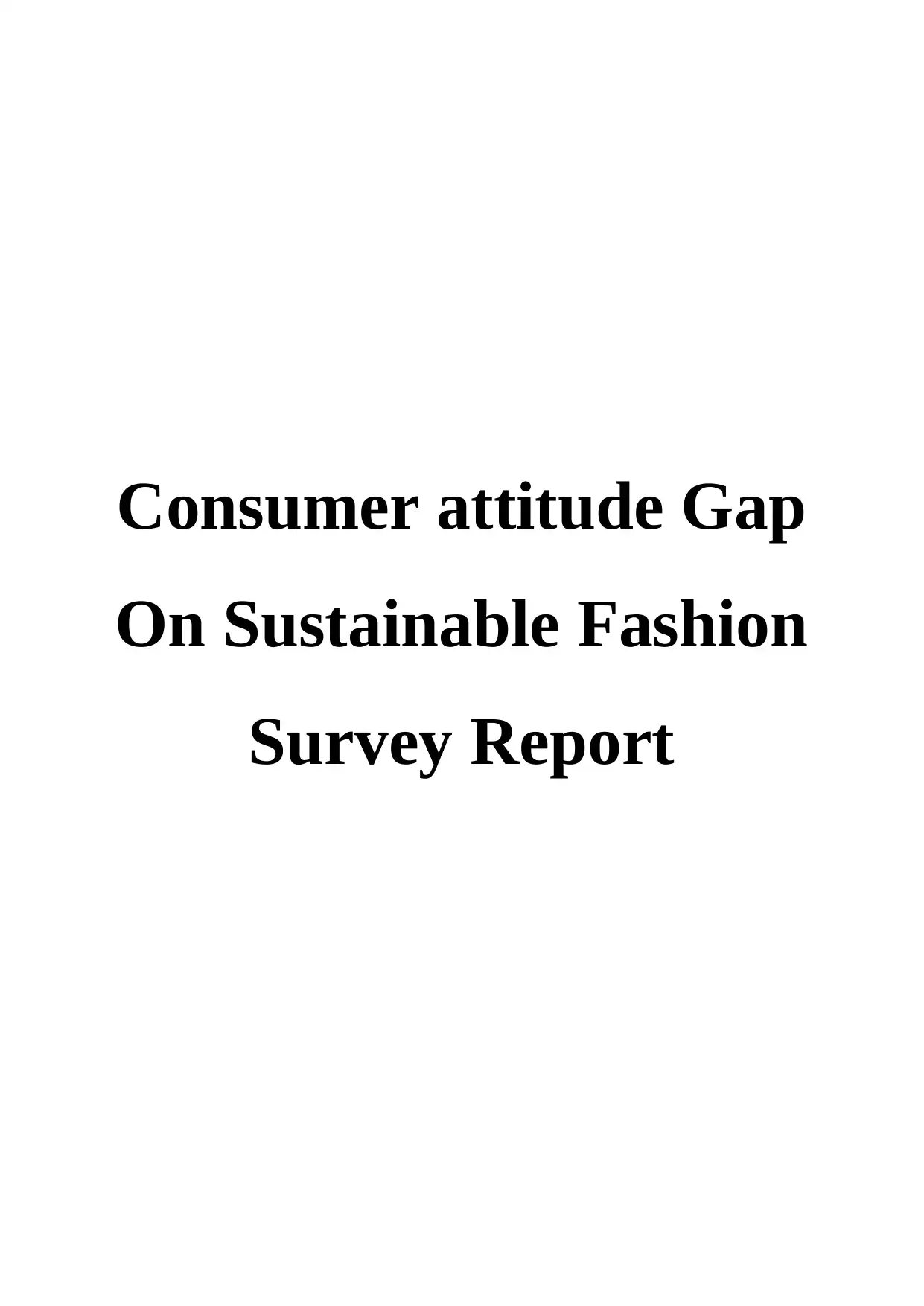
Consumer attitude Gap
On Sustainable Fashion
Survey Report
On Sustainable Fashion
Survey Report
Paraphrase This Document
Need a fresh take? Get an instant paraphrase of this document with our AI Paraphraser

Contents
Introduction................................................................................................................................3
Main Body..................................................................................................................................3
Recommendation......................................................................................................................13
References................................................................................................................................15
Introduction................................................................................................................................3
Main Body..................................................................................................................................3
Recommendation......................................................................................................................13
References................................................................................................................................15
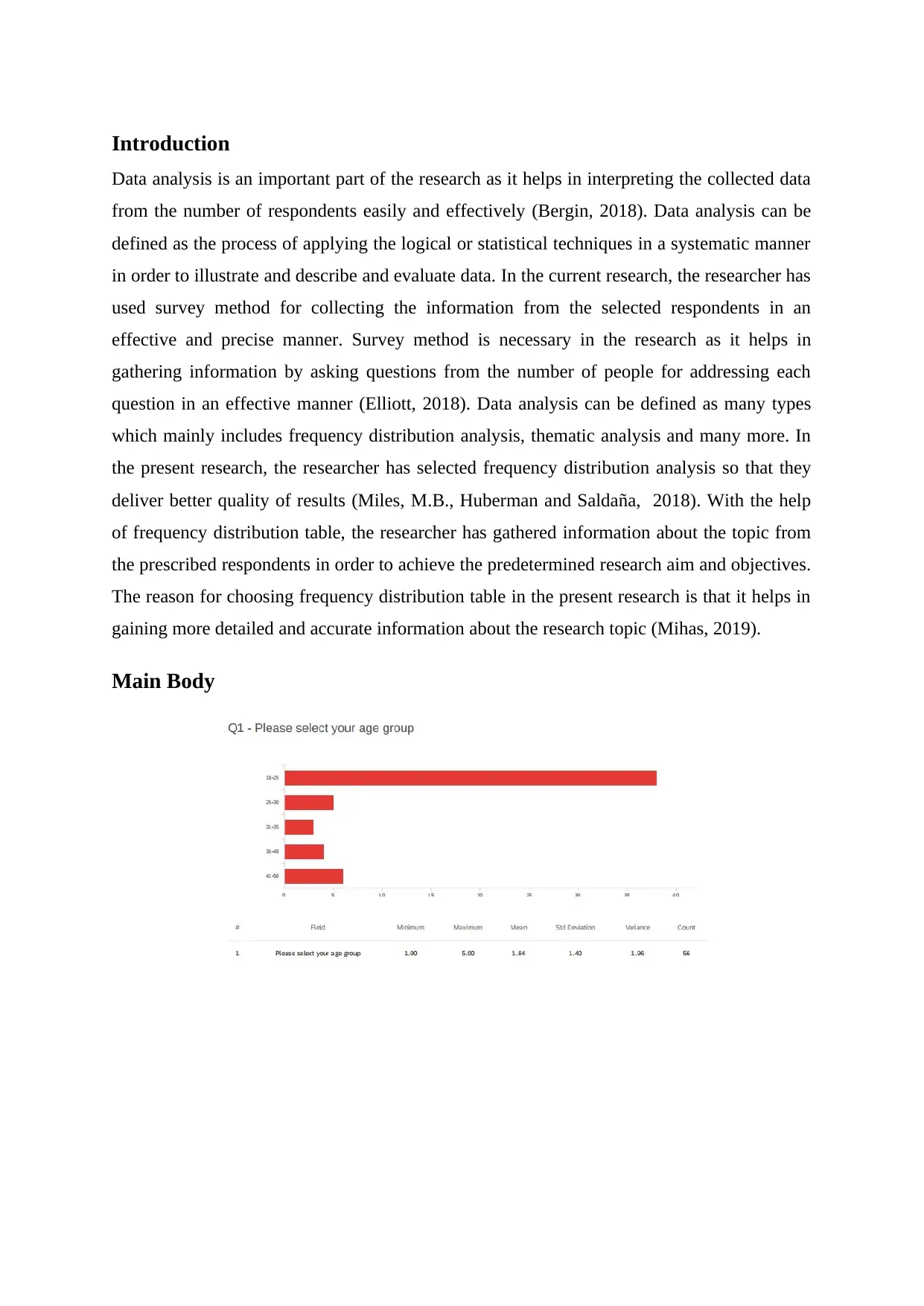
Introduction
Data analysis is an important part of the research as it helps in interpreting the collected data
from the number of respondents easily and effectively (Bergin, 2018). Data analysis can be
defined as the process of applying the logical or statistical techniques in a systematic manner
in order to illustrate and describe and evaluate data. In the current research, the researcher has
used survey method for collecting the information from the selected respondents in an
effective and precise manner. Survey method is necessary in the research as it helps in
gathering information by asking questions from the number of people for addressing each
question in an effective manner (Elliott, 2018). Data analysis can be defined as many types
which mainly includes frequency distribution analysis, thematic analysis and many more. In
the present research, the researcher has selected frequency distribution analysis so that they
deliver better quality of results (Miles, M.B., Huberman and Saldaña, 2018). With the help
of frequency distribution table, the researcher has gathered information about the topic from
the prescribed respondents in order to achieve the predetermined research aim and objectives.
The reason for choosing frequency distribution table in the present research is that it helps in
gaining more detailed and accurate information about the research topic (Mihas, 2019).
Main Body
Data analysis is an important part of the research as it helps in interpreting the collected data
from the number of respondents easily and effectively (Bergin, 2018). Data analysis can be
defined as the process of applying the logical or statistical techniques in a systematic manner
in order to illustrate and describe and evaluate data. In the current research, the researcher has
used survey method for collecting the information from the selected respondents in an
effective and precise manner. Survey method is necessary in the research as it helps in
gathering information by asking questions from the number of people for addressing each
question in an effective manner (Elliott, 2018). Data analysis can be defined as many types
which mainly includes frequency distribution analysis, thematic analysis and many more. In
the present research, the researcher has selected frequency distribution analysis so that they
deliver better quality of results (Miles, M.B., Huberman and Saldaña, 2018). With the help
of frequency distribution table, the researcher has gathered information about the topic from
the prescribed respondents in order to achieve the predetermined research aim and objectives.
The reason for choosing frequency distribution table in the present research is that it helps in
gaining more detailed and accurate information about the research topic (Mihas, 2019).
Main Body
⊘ This is a preview!⊘
Do you want full access?
Subscribe today to unlock all pages.

Trusted by 1+ million students worldwide
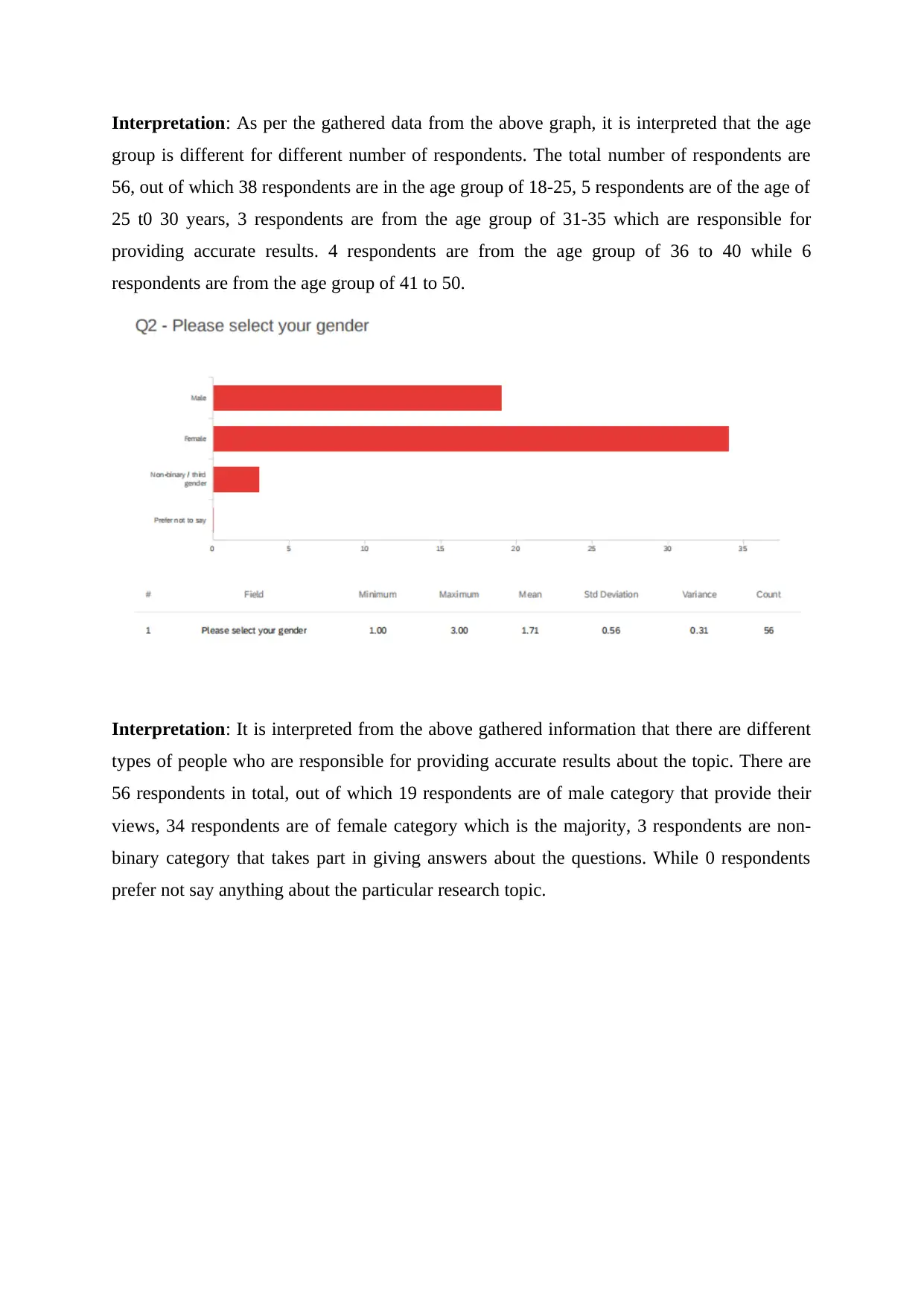
Interpretation: As per the gathered data from the above graph, it is interpreted that the age
group is different for different number of respondents. The total number of respondents are
56, out of which 38 respondents are in the age group of 18-25, 5 respondents are of the age of
25 t0 30 years, 3 respondents are from the age group of 31-35 which are responsible for
providing accurate results. 4 respondents are from the age group of 36 to 40 while 6
respondents are from the age group of 41 to 50.
Interpretation: It is interpreted from the above gathered information that there are different
types of people who are responsible for providing accurate results about the topic. There are
56 respondents in total, out of which 19 respondents are of male category that provide their
views, 34 respondents are of female category which is the majority, 3 respondents are non-
binary category that takes part in giving answers about the questions. While 0 respondents
prefer not say anything about the particular research topic.
group is different for different number of respondents. The total number of respondents are
56, out of which 38 respondents are in the age group of 18-25, 5 respondents are of the age of
25 t0 30 years, 3 respondents are from the age group of 31-35 which are responsible for
providing accurate results. 4 respondents are from the age group of 36 to 40 while 6
respondents are from the age group of 41 to 50.
Interpretation: It is interpreted from the above gathered information that there are different
types of people who are responsible for providing accurate results about the topic. There are
56 respondents in total, out of which 19 respondents are of male category that provide their
views, 34 respondents are of female category which is the majority, 3 respondents are non-
binary category that takes part in giving answers about the questions. While 0 respondents
prefer not say anything about the particular research topic.
Paraphrase This Document
Need a fresh take? Get an instant paraphrase of this document with our AI Paraphraser
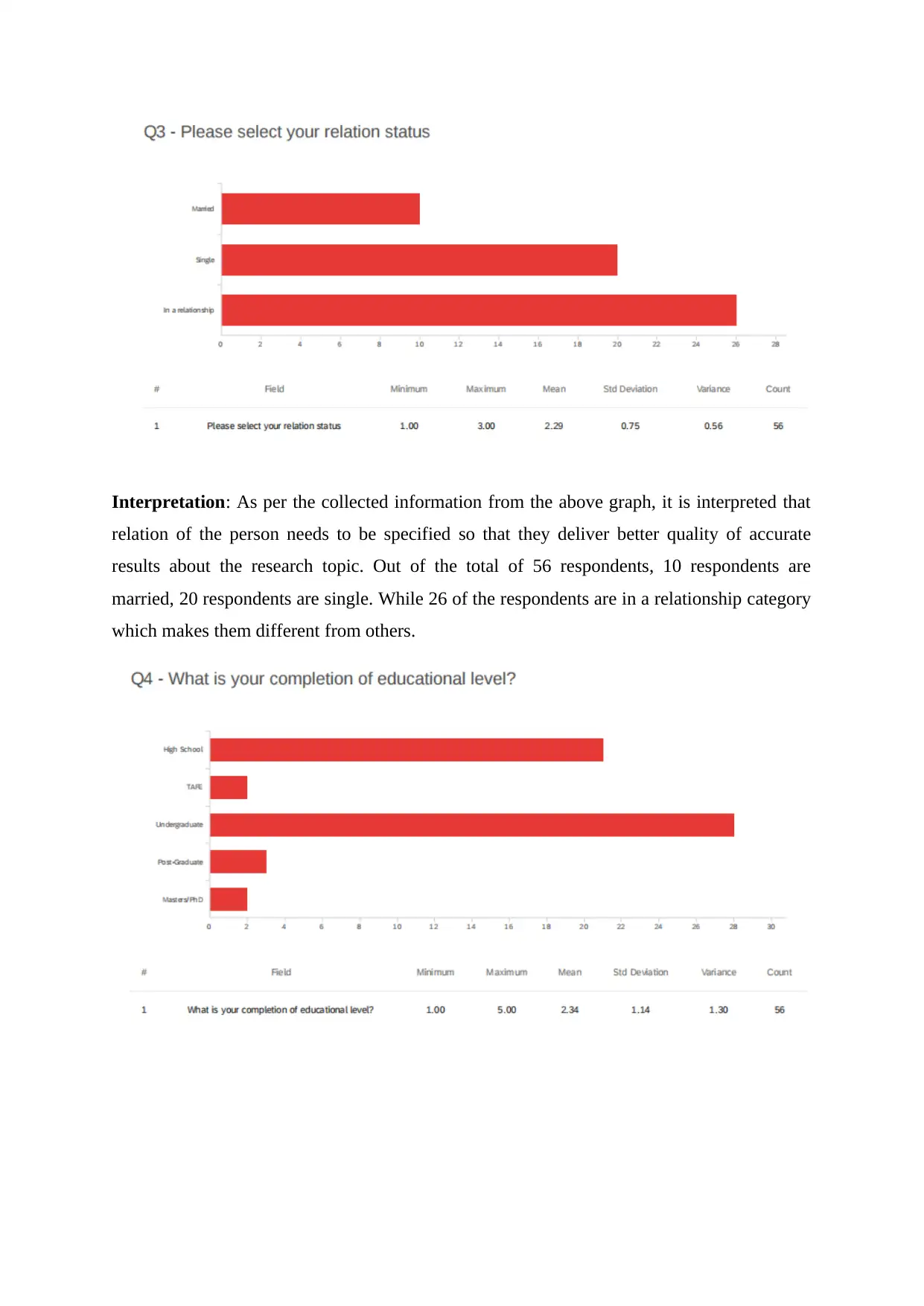
Interpretation: As per the collected information from the above graph, it is interpreted that
relation of the person needs to be specified so that they deliver better quality of accurate
results about the research topic. Out of the total of 56 respondents, 10 respondents are
married, 20 respondents are single. While 26 of the respondents are in a relationship category
which makes them different from others.
relation of the person needs to be specified so that they deliver better quality of accurate
results about the research topic. Out of the total of 56 respondents, 10 respondents are
married, 20 respondents are single. While 26 of the respondents are in a relationship category
which makes them different from others.
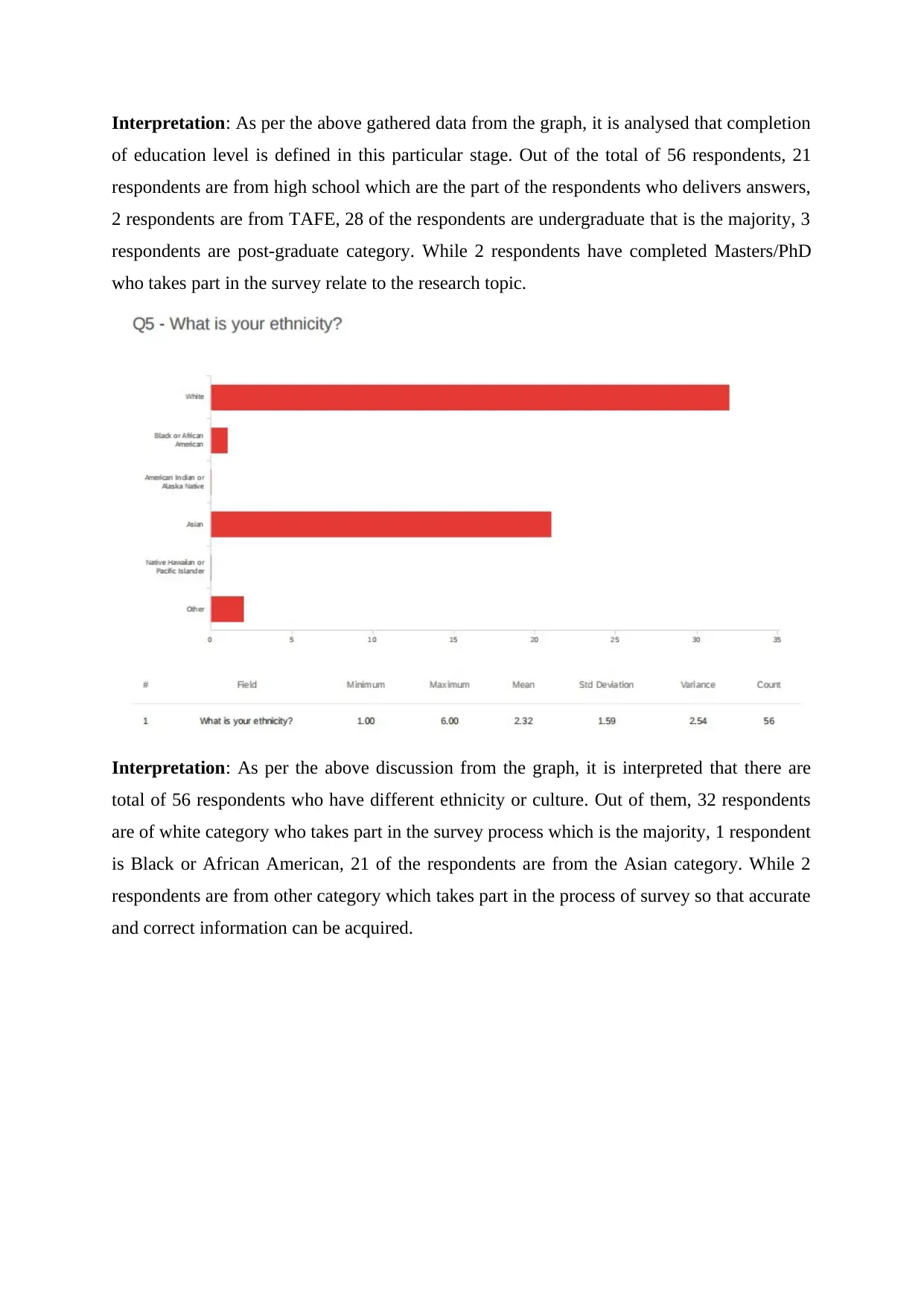
Interpretation: As per the above gathered data from the graph, it is analysed that completion
of education level is defined in this particular stage. Out of the total of 56 respondents, 21
respondents are from high school which are the part of the respondents who delivers answers,
2 respondents are from TAFE, 28 of the respondents are undergraduate that is the majority, 3
respondents are post-graduate category. While 2 respondents have completed Masters/PhD
who takes part in the survey relate to the research topic.
Interpretation: As per the above discussion from the graph, it is interpreted that there are
total of 56 respondents who have different ethnicity or culture. Out of them, 32 respondents
are of white category who takes part in the survey process which is the majority, 1 respondent
is Black or African American, 21 of the respondents are from the Asian category. While 2
respondents are from other category which takes part in the process of survey so that accurate
and correct information can be acquired.
of education level is defined in this particular stage. Out of the total of 56 respondents, 21
respondents are from high school which are the part of the respondents who delivers answers,
2 respondents are from TAFE, 28 of the respondents are undergraduate that is the majority, 3
respondents are post-graduate category. While 2 respondents have completed Masters/PhD
who takes part in the survey relate to the research topic.
Interpretation: As per the above discussion from the graph, it is interpreted that there are
total of 56 respondents who have different ethnicity or culture. Out of them, 32 respondents
are of white category who takes part in the survey process which is the majority, 1 respondent
is Black or African American, 21 of the respondents are from the Asian category. While 2
respondents are from other category which takes part in the process of survey so that accurate
and correct information can be acquired.
⊘ This is a preview!⊘
Do you want full access?
Subscribe today to unlock all pages.

Trusted by 1+ million students worldwide
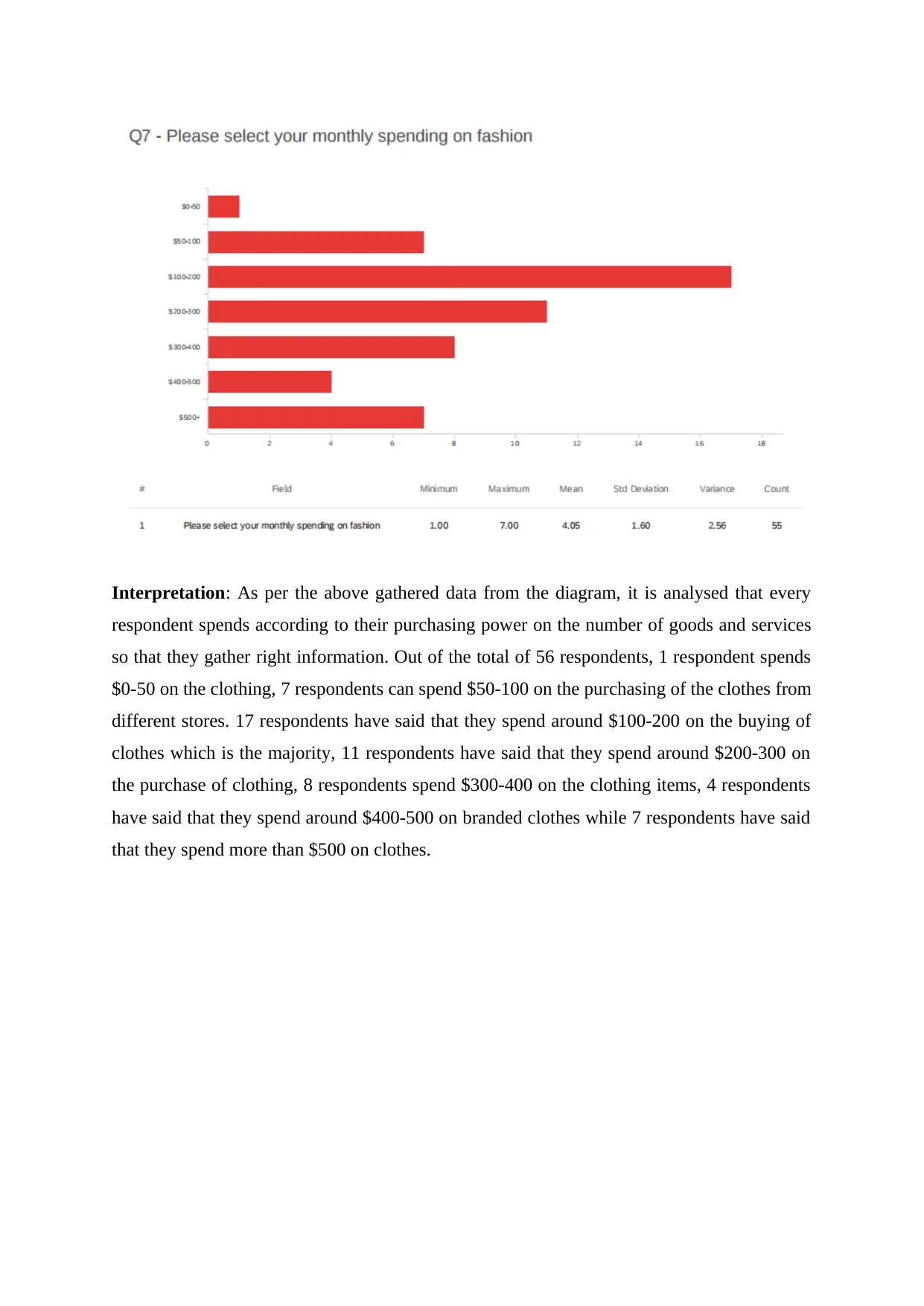
Interpretation: As per the above gathered data from the diagram, it is analysed that every
respondent spends according to their purchasing power on the number of goods and services
so that they gather right information. Out of the total of 56 respondents, 1 respondent spends
$0-50 on the clothing, 7 respondents can spend $50-100 on the purchasing of the clothes from
different stores. 17 respondents have said that they spend around $100-200 on the buying of
clothes which is the majority, 11 respondents have said that they spend around $200-300 on
the purchase of clothing, 8 respondents spend $300-400 on the clothing items, 4 respondents
have said that they spend around $400-500 on branded clothes while 7 respondents have said
that they spend more than $500 on clothes.
respondent spends according to their purchasing power on the number of goods and services
so that they gather right information. Out of the total of 56 respondents, 1 respondent spends
$0-50 on the clothing, 7 respondents can spend $50-100 on the purchasing of the clothes from
different stores. 17 respondents have said that they spend around $100-200 on the buying of
clothes which is the majority, 11 respondents have said that they spend around $200-300 on
the purchase of clothing, 8 respondents spend $300-400 on the clothing items, 4 respondents
have said that they spend around $400-500 on branded clothes while 7 respondents have said
that they spend more than $500 on clothes.
Paraphrase This Document
Need a fresh take? Get an instant paraphrase of this document with our AI Paraphraser
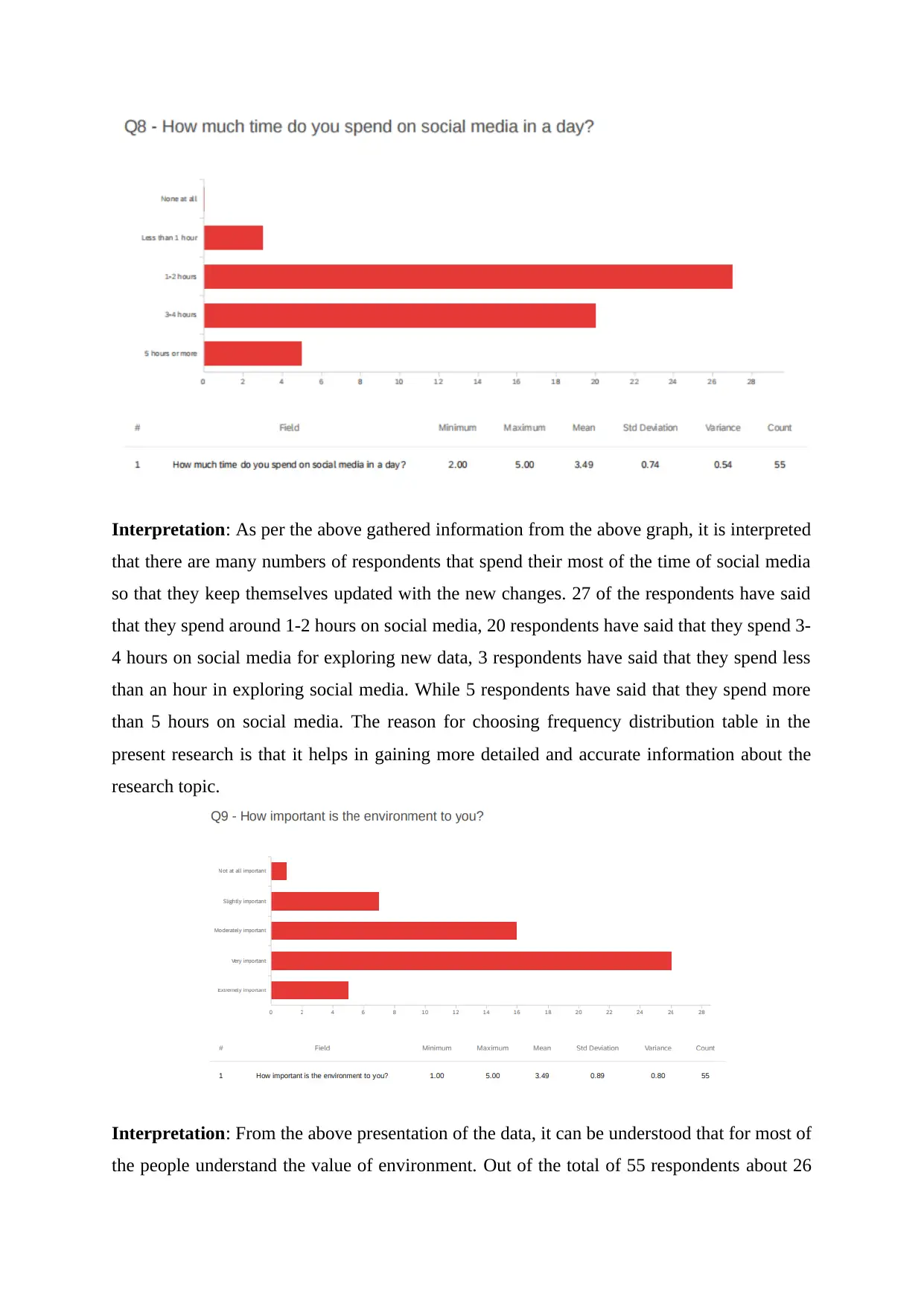
Interpretation: As per the above gathered information from the above graph, it is interpreted
that there are many numbers of respondents that spend their most of the time of social media
so that they keep themselves updated with the new changes. 27 of the respondents have said
that they spend around 1-2 hours on social media, 20 respondents have said that they spend 3-
4 hours on social media for exploring new data, 3 respondents have said that they spend less
than an hour in exploring social media. While 5 respondents have said that they spend more
than 5 hours on social media. The reason for choosing frequency distribution table in the
present research is that it helps in gaining more detailed and accurate information about the
research topic.
Interpretation: From the above presentation of the data, it can be understood that for most of
the people understand the value of environment. Out of the total of 55 respondents about 26
that there are many numbers of respondents that spend their most of the time of social media
so that they keep themselves updated with the new changes. 27 of the respondents have said
that they spend around 1-2 hours on social media, 20 respondents have said that they spend 3-
4 hours on social media for exploring new data, 3 respondents have said that they spend less
than an hour in exploring social media. While 5 respondents have said that they spend more
than 5 hours on social media. The reason for choosing frequency distribution table in the
present research is that it helps in gaining more detailed and accurate information about the
research topic.
Interpretation: From the above presentation of the data, it can be understood that for most of
the people understand the value of environment. Out of the total of 55 respondents about 26
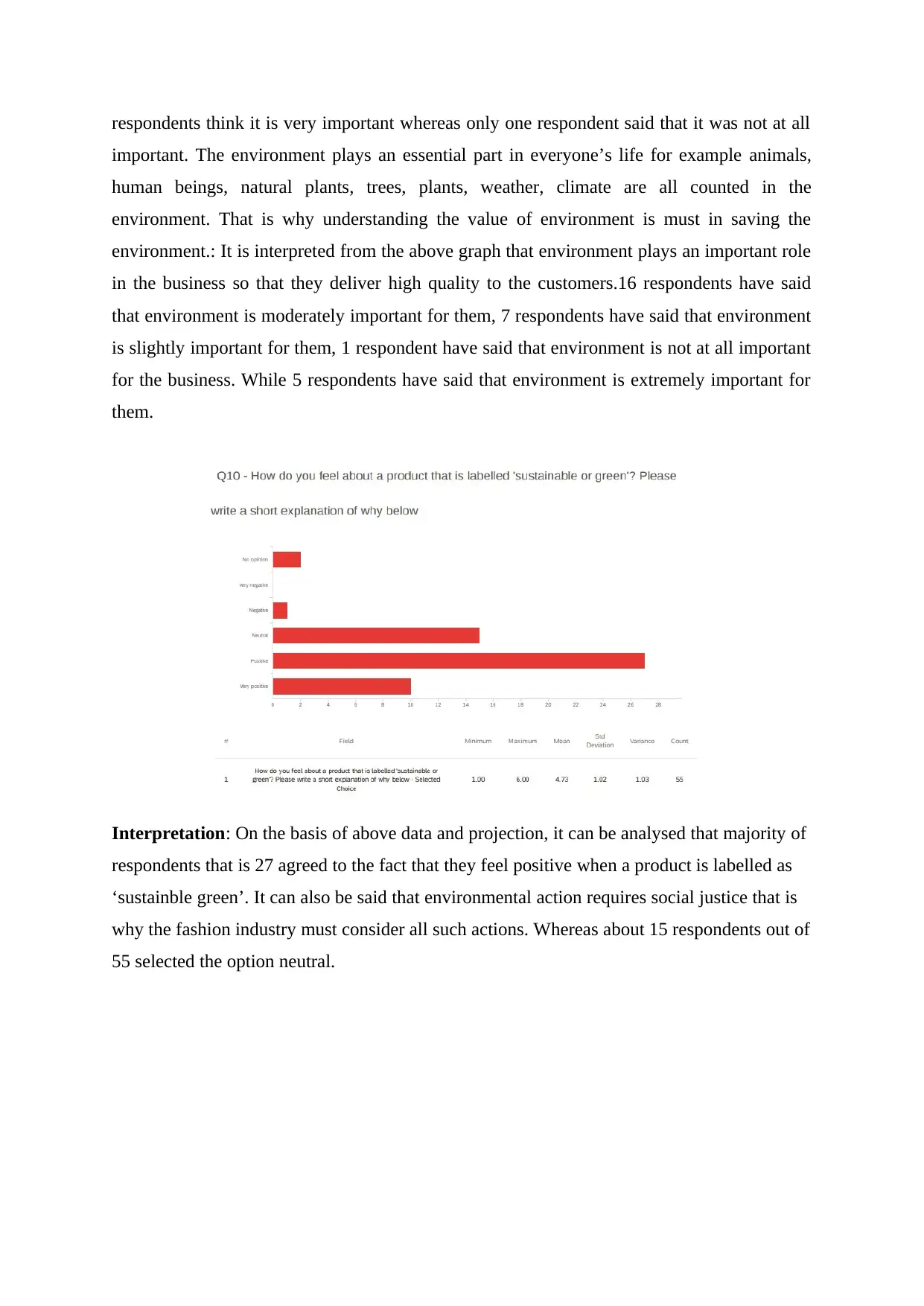
respondents think it is very important whereas only one respondent said that it was not at all
important. The environment plays an essential part in everyone’s life for example animals,
human beings, natural plants, trees, plants, weather, climate are all counted in the
environment. That is why understanding the value of environment is must in saving the
environment.: It is interpreted from the above graph that environment plays an important role
in the business so that they deliver high quality to the customers.16 respondents have said
that environment is moderately important for them, 7 respondents have said that environment
is slightly important for them, 1 respondent have said that environment is not at all important
for the business. While 5 respondents have said that environment is extremely important for
them.
Interpretation: On the basis of above data and projection, it can be analysed that majority of
respondents that is 27 agreed to the fact that they feel positive when a product is labelled as
‘sustainble green’. It can also be said that environmental action requires social justice that is
why the fashion industry must consider all such actions. Whereas about 15 respondents out of
55 selected the option neutral.
important. The environment plays an essential part in everyone’s life for example animals,
human beings, natural plants, trees, plants, weather, climate are all counted in the
environment. That is why understanding the value of environment is must in saving the
environment.: It is interpreted from the above graph that environment plays an important role
in the business so that they deliver high quality to the customers.16 respondents have said
that environment is moderately important for them, 7 respondents have said that environment
is slightly important for them, 1 respondent have said that environment is not at all important
for the business. While 5 respondents have said that environment is extremely important for
them.
Interpretation: On the basis of above data and projection, it can be analysed that majority of
respondents that is 27 agreed to the fact that they feel positive when a product is labelled as
‘sustainble green’. It can also be said that environmental action requires social justice that is
why the fashion industry must consider all such actions. Whereas about 15 respondents out of
55 selected the option neutral.
⊘ This is a preview!⊘
Do you want full access?
Subscribe today to unlock all pages.

Trusted by 1+ million students worldwide
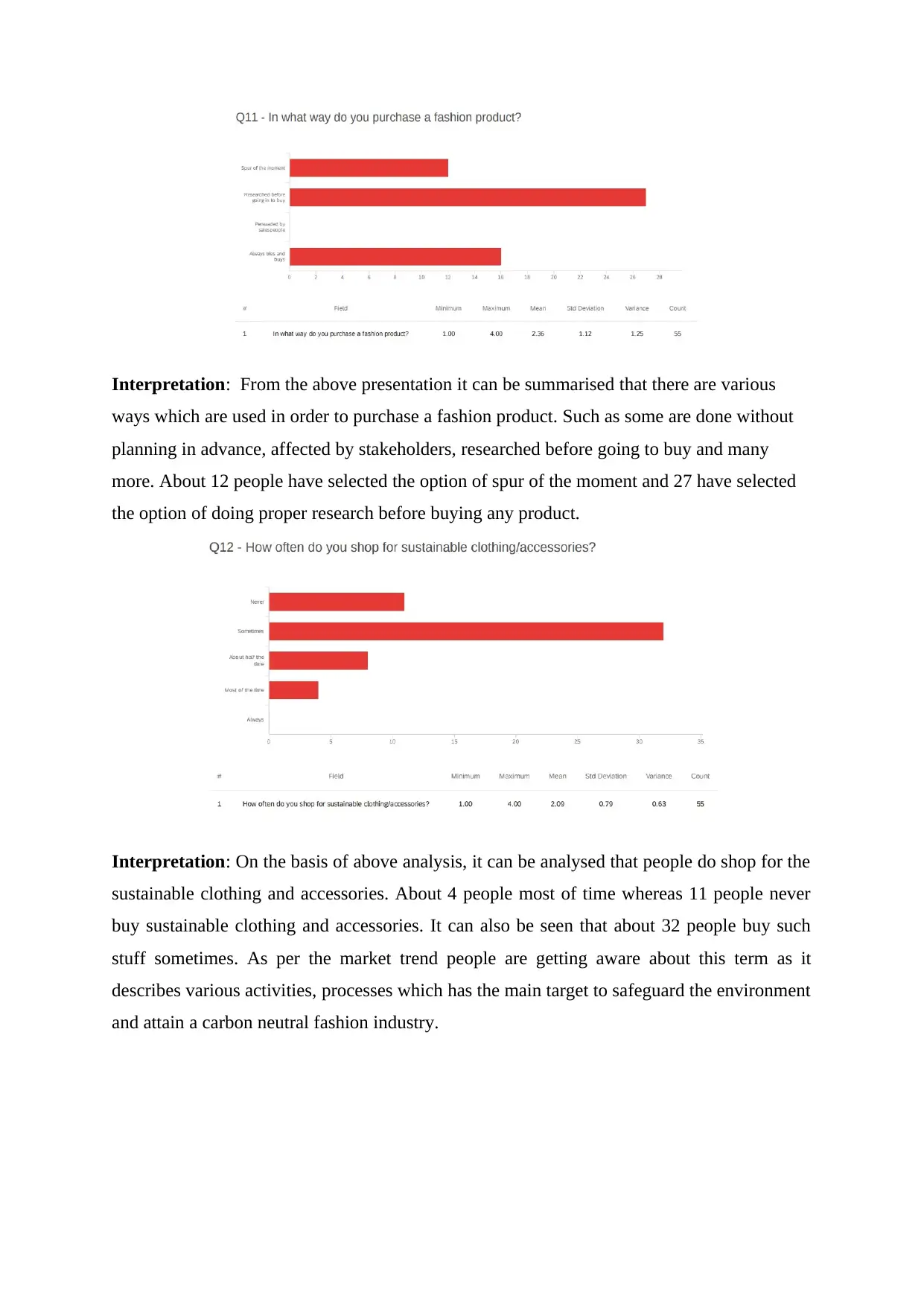
Interpretation: From the above presentation it can be summarised that there are various
ways which are used in order to purchase a fashion product. Such as some are done without
planning in advance, affected by stakeholders, researched before going to buy and many
more. About 12 people have selected the option of spur of the moment and 27 have selected
the option of doing proper research before buying any product.
Interpretation: On the basis of above analysis, it can be analysed that people do shop for the
sustainable clothing and accessories. About 4 people most of time whereas 11 people never
buy sustainable clothing and accessories. It can also be seen that about 32 people buy such
stuff sometimes. As per the market trend people are getting aware about this term as it
describes various activities, processes which has the main target to safeguard the environment
and attain a carbon neutral fashion industry.
ways which are used in order to purchase a fashion product. Such as some are done without
planning in advance, affected by stakeholders, researched before going to buy and many
more. About 12 people have selected the option of spur of the moment and 27 have selected
the option of doing proper research before buying any product.
Interpretation: On the basis of above analysis, it can be analysed that people do shop for the
sustainable clothing and accessories. About 4 people most of time whereas 11 people never
buy sustainable clothing and accessories. It can also be seen that about 32 people buy such
stuff sometimes. As per the market trend people are getting aware about this term as it
describes various activities, processes which has the main target to safeguard the environment
and attain a carbon neutral fashion industry.
Paraphrase This Document
Need a fresh take? Get an instant paraphrase of this document with our AI Paraphraser
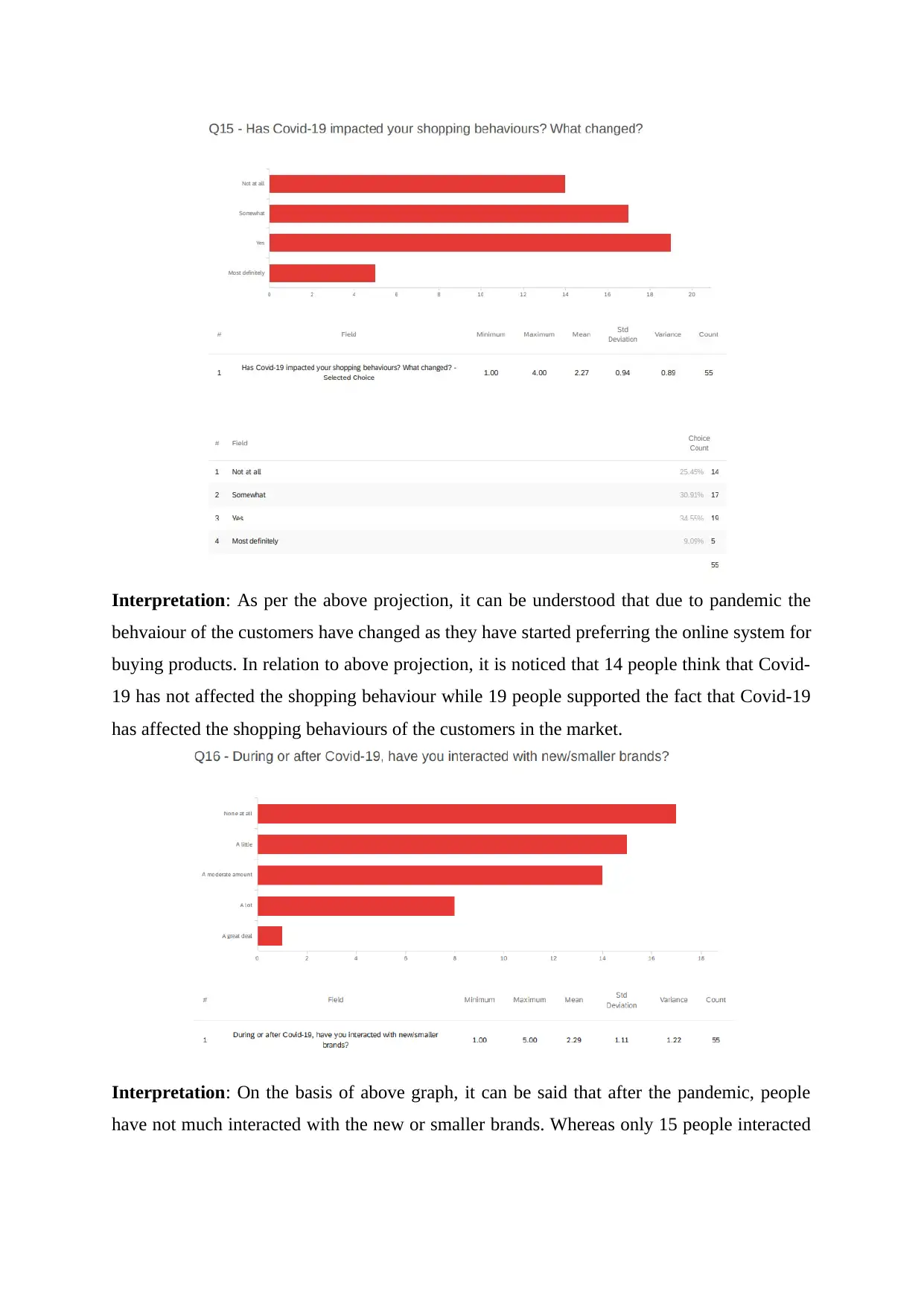
Interpretation: As per the above projection, it can be understood that due to pandemic the
behvaiour of the customers have changed as they have started preferring the online system for
buying products. In relation to above projection, it is noticed that 14 people think that Covid-
19 has not affected the shopping behaviour while 19 people supported the fact that Covid-19
has affected the shopping behaviours of the customers in the market.
Interpretation: On the basis of above graph, it can be said that after the pandemic, people
have not much interacted with the new or smaller brands. Whereas only 15 people interacted
behvaiour of the customers have changed as they have started preferring the online system for
buying products. In relation to above projection, it is noticed that 14 people think that Covid-
19 has not affected the shopping behaviour while 19 people supported the fact that Covid-19
has affected the shopping behaviours of the customers in the market.
Interpretation: On the basis of above graph, it can be said that after the pandemic, people
have not much interacted with the new or smaller brands. Whereas only 15 people interacted
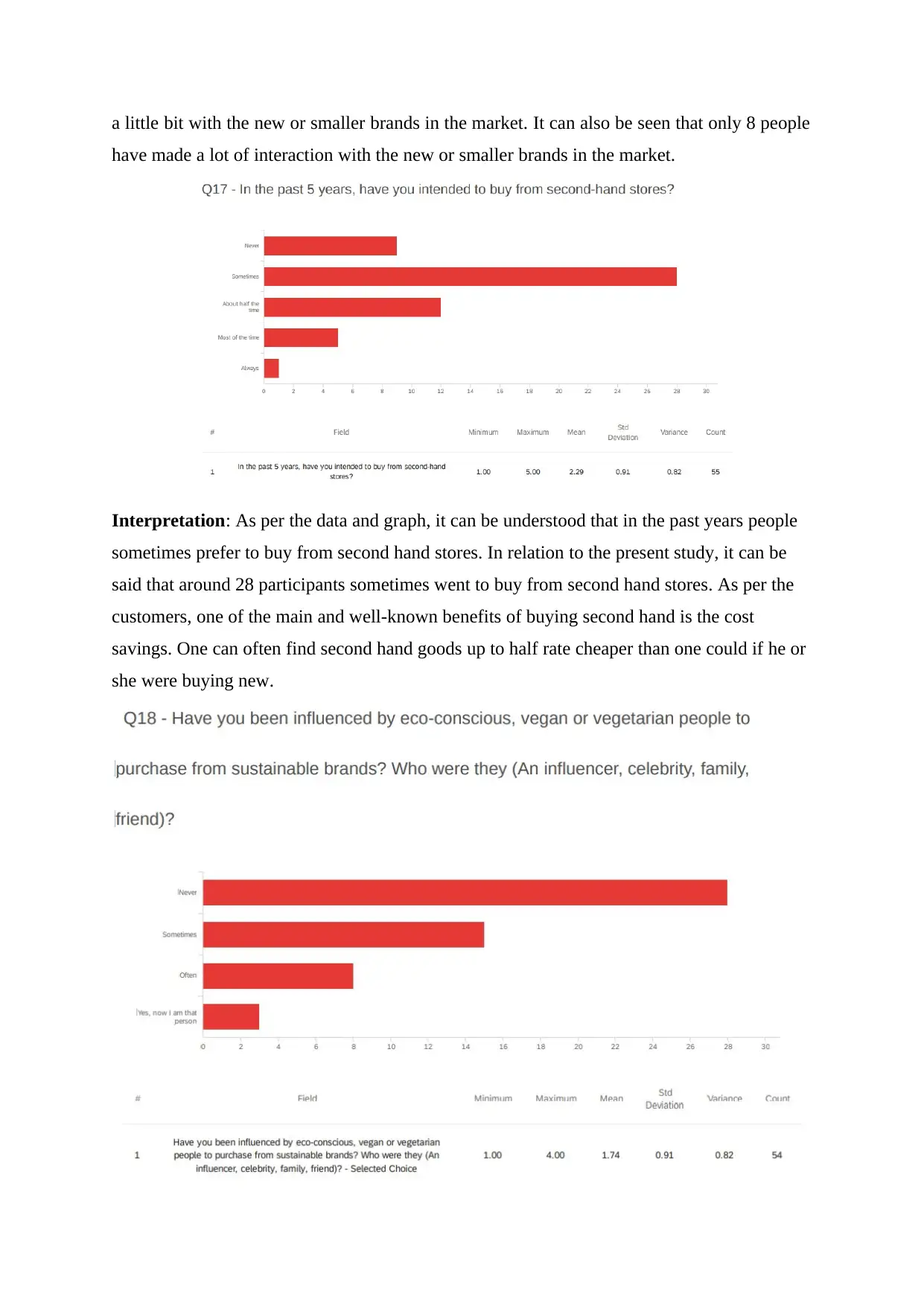
a little bit with the new or smaller brands in the market. It can also be seen that only 8 people
have made a lot of interaction with the new or smaller brands in the market.
Interpretation: As per the data and graph, it can be understood that in the past years people
sometimes prefer to buy from second hand stores. In relation to the present study, it can be
said that around 28 participants sometimes went to buy from second hand stores. As per the
customers, one of the main and well-known benefits of buying second hand is the cost
savings. One can often find second hand goods up to half rate cheaper than one could if he or
she were buying new.
have made a lot of interaction with the new or smaller brands in the market.
Interpretation: As per the data and graph, it can be understood that in the past years people
sometimes prefer to buy from second hand stores. In relation to the present study, it can be
said that around 28 participants sometimes went to buy from second hand stores. As per the
customers, one of the main and well-known benefits of buying second hand is the cost
savings. One can often find second hand goods up to half rate cheaper than one could if he or
she were buying new.
⊘ This is a preview!⊘
Do you want full access?
Subscribe today to unlock all pages.

Trusted by 1+ million students worldwide
1 out of 18
Related Documents
Your All-in-One AI-Powered Toolkit for Academic Success.
+13062052269
info@desklib.com
Available 24*7 on WhatsApp / Email
![[object Object]](/_next/static/media/star-bottom.7253800d.svg)
Unlock your academic potential
Copyright © 2020–2025 A2Z Services. All Rights Reserved. Developed and managed by ZUCOL.





